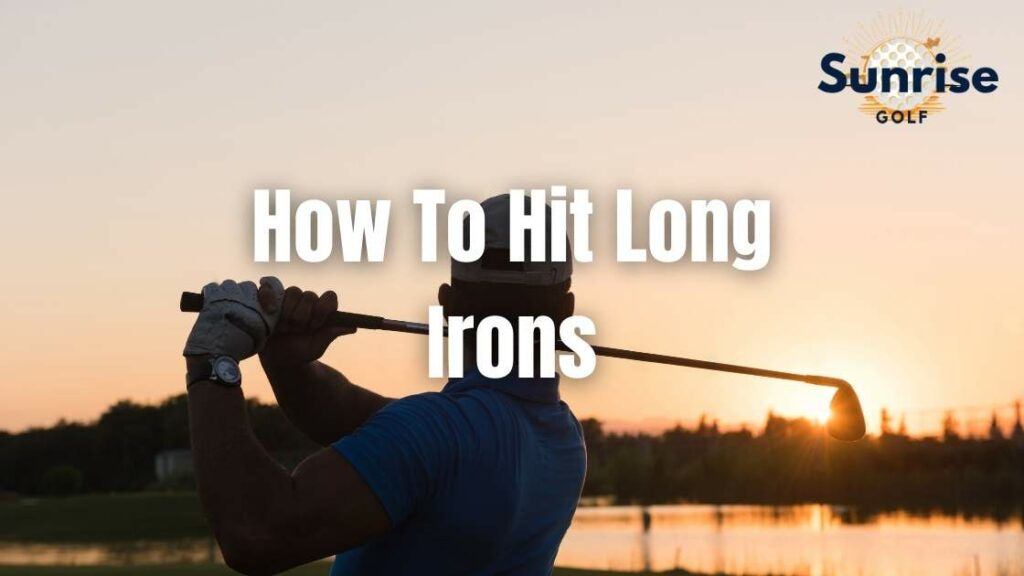Are you struggling to hit long irons consistently and with confidence?
Imagine standing on the fairway, lined up with the pin, and effortlessly launching a high, controlled shot that lands on the green.
In this article, we’ll guide you through the essential techniques and strategies to help you master your long iron game.
From grip and setup to swing mechanics and club selection, we’ll provide you with the knowledge and tools you need to improve your long iron shots and unlock your true potential on the course.
Let’s get started!
Grip and Setup Techniques
To improve your long iron shots, grip the club firmly and position yourself with a balanced setup. Proper hand placement and alignment are key factors in achieving consistent and powerful long iron shots.
When it comes to hand placement, start by placing your top hand (left hand for right-handed golfers) on the club with your thumb resting on top of the grip. The index finger should be extended down the shaft, creating a V shape with the thumb. Your bottom hand (right hand for right-handed golfers) should grip the club with the lifeline of your palm resting on top of the thumb of your top hand. This grip will allow for better control and a more powerful swing.
In terms of alignment, it’s crucial to have a square stance and aim your clubface at your target. To achieve this, position your feet shoulder-width apart with your toes, knees, hips, and shoulders all parallel to the target line. Visualize a straight line extending from your target through your body to ensure proper alignment.
Proper Ball Positioning
Place the golf ball in the correct position in order to optimize your long iron shots. Proper ball positioning is crucial for achieving both ball flight control and distance control with your long irons. By understanding the correct placement of the ball in your stance, you can greatly improve your chances of hitting solid and accurate shots.
To help you visualize the ideal ball position, refer to the table below:
| Club | Ball Position |
|---|---|
| 2-iron | Slightly forward of center |
| 3-iron | Just left of center |
| 4-iron | Center of stance |
| 5-iron | Just right of center |
| 6-iron | Slightly forward of center |
Keep in mind that these positions are general guidelines and may vary depending on your swing style and preferences. However, as a starting point, they provide a solid foundation for consistent ball striking.
When the ball is placed too far back in your stance, it can result in a lower ball flight and less distance. On the other hand, if the ball is positioned too far forward, it may cause a higher ball flight and potential loss of control.
Experiment with different ball positions during practice sessions to find the optimal spot that allows you to strike the ball cleanly and achieve the desired ball flight and distance control. Remember, freedom in your swing comes from finding the right balance in your setup, including the proper ball positioning.
Swing Mechanics and Tempo
As you swing your long irons, focus on maintaining proper mechanics and a consistent tempo throughout your entire swing. This is crucial for achieving maximum distance and accuracy.
One key aspect to pay attention to is weight transfer and balance. As you start your backswing, make sure to shift your weight onto your right foot (if you’re right-handed) and maintain a balanced stance. This will allow you to generate power and create a stable base for the rest of your swing.
As you transition into the downswing, smoothly transfer your weight onto your left foot, leading with your hips and upper body. This transfer of weight will help you generate more clubhead speed and compress the ball at impact.
Another important aspect of swing mechanics is the follow-through and finish. After making contact with the ball, continue your swing with a smooth and controlled motion. Extend your arms fully and rotate your body towards the target. This will help you maintain a consistent tempo and ensure a complete follow-through.
Avoid stopping abruptly after impact, as it can negatively affect your accuracy and distance. Instead, focus on maintaining a balanced and fluid finish.
Club Selection and Loft Considerations
When choosing which club to use and considering the loft, it’s important to take into account various factors to optimize your long iron shots. Club fitting and ball flight analysis play a crucial role in determining the right club and loft for your swing.
Club fitting involves finding the perfect fit for your swing characteristics and physical attributes. A professional club fitter can analyze your swing speed, angle of attack, and release pattern to recommend the ideal long iron for you. They’ll also consider your height, arm length, and playing ability to ensure the club fits you perfectly.
Ball flight analysis is another important aspect of club selection. By observing how the ball behaves during flight, you can determine if you need a higher or lower lofted long iron. If your shots consistently fly too high, a lower lofted club may be more suitable. Conversely, if your shots tend to fly too low, a higher lofted club can help increase trajectory and distance.
Practicing and Improving Long Iron Shots
To consistently improve your long iron shots, practice hitting them at least once a week on the driving range. This regular practice will help you develop the necessary skills and confidence to hit long iron shots effectively on the course.
When practicing, it’s important to focus on both shot shaping techniques and mental strategies. Shot shaping techniques can greatly enhance your long iron shots. Experiment with different ball positions and grips to find the one that works best for you. Additionally, try adjusting your stance and posture to optimize your swing path and contact with the ball. Practicing different shot shapes, such as fades and draws, will also help you become more versatile on the course.
In addition to shot shaping techniques, mental strategies play a crucial role in improving long iron shots. Develop a pre-shot routine that helps you stay focused and confident before each shot. Visualize successful shots and imagine the ball flying towards your target. Practice deep breathing and relaxation techniques to help calm your mind and body during the swing.
Remember, consistency and patience are key when practicing long iron shots. Stay committed to your practice routine, and over time, you’ll see improvement in your long iron shots. Keep a positive mindset and believe in your abilities.
With dedication and practice, you’ll become more proficient in hitting long iron shots and gain the freedom to navigate the course with confidence.
Conclusion
So there you have it, a guide on how to hit long irons. By following the grip and setup techniques, positioning the ball correctly, and mastering swing mechanics and tempo, you’ll be on your way to achieving those long iron shots.
Additionally, club selection and loft considerations are essential for success. With practice, you can improve your long iron shots and become a more confident and skilled golfer.
Don’t let the difficulty of long irons discourage you; with determination and patience, you can conquer them and elevate your game to new heights.

